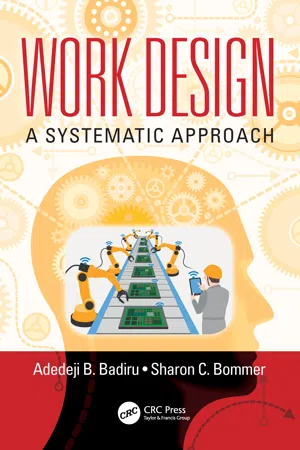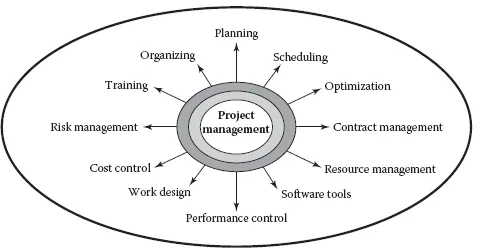
This is a test
- 314 pages
- English
- ePUB (mobile friendly)
- Available on iOS & Android
eBook - ePub
Book details
Book preview
Table of contents
Citations
About This Book
Work is all around us and permeates everything we do and everyday activities. Not all work is justified, not all work is properly designed, or evaluated accurately, or integrated. A systems model will make work more achievable through better management. Work is defined as a process of performing a defined task or activity, such as research, development, operations, maintenance, repair, assembly, production, and so on. Very little is written on how to design, evaluate, justify, and integrate work. Using a comprehensive systems approach, this book facilitates a better understanding of work for the purpose of making it more effective and rewarding.
Frequently asked questions
At the moment all of our mobile-responsive ePub books are available to download via the app. Most of our PDFs are also available to download and we're working on making the final remaining ones downloadable now. Learn more here.
Both plans give you full access to the library and all of Perlego’s features. The only differences are the price and subscription period: With the annual plan you’ll save around 30% compared to 12 months on the monthly plan.
We are an online textbook subscription service, where you can get access to an entire online library for less than the price of a single book per month. With over 1 million books across 1000+ topics, we’ve got you covered! Learn more here.
Look out for the read-aloud symbol on your next book to see if you can listen to it. The read-aloud tool reads text aloud for you, highlighting the text as it is being read. You can pause it, speed it up and slow it down. Learn more here.
Yes, you can access Work Design by Adedeji B. Badiru,Sharon C. Bommer in PDF and/or ePUB format, as well as other popular books in Technologie et ingénierie & Ingénierie. We have over one million books available in our catalogue for you to explore.
Information
chapter ten
Project management for work management
Every work element should be managed as a project. Project management is work management and vice versa. If they are not managed like projects, some work elements run the risk of being means to no end. Badiru (2016) comments, “It is our natural biological imperative to work […] unfortunately there is no imperative for that work to be useful.” Project management is the process of managing, allocating, and timing resources in order to achieve a given objective in an expedient manner. The objective may be stated in terms of time (schedule), performance output (quality), or cost (budget). It is the process of achieving objectives by utilizing the combined capabilities of available resources. Time is often the most critical aspect of managing any project. Time is the physical platform on which project accomplishments are made. So, it must be managed concurrently with any other important aspects in a project. Project management covers the following basic functions:
1.Planning
2.Organizing
3.Scheduling
4.Control
The complexity of a project can range from simple, such as the painting of a vacant room, to very complex, such as the introduction of a new high-tech product. The technical differences between project types are of great importance when selecting and applying project management techniques. Figure 10.1 illustrates the various dimensions of the application of project management to an industrial system.

Figure 10.1Multiple dimensions of project management.
Project management techniques are widely used in many human endeavors, such as construction, banking, manufacturing, marketing, health care, sales, transportation, and research and development, as well as in academic, legal, political, and government establishments, just to name a few. In many situations, the on-time completion of a project is of paramount importance. Delayed or unsuccessful projects not only translate to monetary losses but also impede subsequent undertakings. Project management takes a hierarchical view of a project environment, covering the following top-down levels:
1.System level
2.Program level
3.Project level
4.Task level
5.Activity level
Project review and selection criteria
Project selection is an essential first step in focusing the efforts of an organization. Figure 10.2 presents a simple graphical evaluation of project selection. The vertical axis represents the value-added basis of the project under consideration, while the horizontal axis represents the level of complexity associated with the project. In this example, value can range from low to high, while complexity can range from easy to difficult. The figure shows four quadrants containing regions of high value with high complexity, low value with high complexity, high value with low complexity, and low value with low complexity. A fuzzy region is identified with an overlay circle. The organization must evaluate each project on the basis of overall organization value streams. The figure can be modified to represent other factors of interest to an organization instead of value-added and project complexity.

Figure 10.2Project selection quadrant: go or no-go.
Criteria for project review
Some of the specific criteria that may be included in project review and selection are as follows:
•Cost reduction
•Customer satisfaction
•Process improvement
•Revenue growth
•Operational responsiveness
•Resource utilization
•Project duration
•Execution complexity
•Cross-functional efficiency
•Partnering potential
Hierarchy of work selection
In addition to evaluating an overall project, the elements making up the project may need to be evaluated on the basis of the following hierarchy. This will facilitate achieving an integrated project management view of the organization’s operations.
•System
•Program
•Task
•Work packages
•Activity
Sizing of projects
Associating a size measure with an industrial project provides a means of determining the level of relevance and the effort required. A simple guideline is as follows:
•Major (over 60 man-months of effort)
•Intermediate (between 6 and 60 man-months)
•Minor (less than 6 man-months)
Planning levels
When selecting projects and their associated work packages, planning should be done in an integrative and hierarchical manner using the following levels of planning:
•Supra level
•Macro level
•Micro level
Hammersmith’s project alert scale: Red, yellow, green convention
Hammersmith (2006) presented a guideline alert scale for project tracking and evaluation. He suggested putting projects into categories of red, yellow, or green with the following definitions:
Red: If not corrected, the project will be late and/or over budget.
Yellow: The project is at risk of turning red.
Green: The project is on time and on budget.
Product assurance concept for corporate projects
Product assurance activities will provide the product deliverables throughout a program development period. These specific activities for continuous effort are to
1.Track and incorporate specific technologies: The technology management task will track pertinent technologies through various means (e.g., vendor surveys and literature research). More importantly, the task will determine strategies to incorporate specific technologies.
2.Analyze technology trends and conduct long-range planning: The output of technology assessments should be used to formulate long-range policies, directions, and research activities so as to promote longevity and evolution.
3.Encourage government and industry leaders’ participation: In order to determine a long-term strategy, technical evaluators need to work closely with government and industry leaders so as to understand their long-range plans. Technology panels may be formed to encourage participation from these leaders.
4.Influence industry directions: As with other development programs, program management can be used to influence industry directions and spawn new technologies. Since the effort can be treated as a model, many technologies and products that have been developed can be applied to other similar systems.
5.Conduct prototyping work: Prototyping will be used to evaluate the suitability, feasibility, and cost of incorporating a particular technology. In essence, it provides a less costly mechanism to test a technology before significant investment is made in the product development process. Technologies that are high risk with high payoffs should be chosen as the primary subjects for prototyping.
Body-of-knowledge methodology
The Project Management Body of Knowledge (PMBOK®) is published and disseminated by the Project Management Institute (PMI). The body of knowledge comprises specific knowledge areas, which are organized into the following broad areas:
1.Project integration management
2.Project scope management
3.Project time management
4.Project cost management
5.Project quality management
6.Project human resource management
7.Project communications management
8.Project risk management
9.Project procurement management
These segments of the PMBOK cover the range of functions associated with any project, particularly complex ones. Multinational projects, particularly, pose unique challenges pertaining to reliable power supplies, efficient communication systems, credible government support, dependable procurement processes, the consistent availability of technology, progressive industrial climates, trustworthy risk mitigation infrastructures, regular supplies of skilled labor, uniform focus on the quality of work, global consciousness, hassle-free bureaucratic processes, coherent safety and security systems, steady law and order, unflinching focus on customer satisfaction, and fair labor relations. Assessing and resolving concerns about these issues in a step-by-step fashion will create a foundation of success for a large project. While no system can be perfect and satisfactory in all aspects, a tolerable trade-off on these factors is essential for project success.
Components of knowledge areas
The key components of each element of the body of knowledge are as follows:
•Integration
•Integrative project charters
•Project scope statements
•Project management plans
•Project execution management
•Change control
•Scop...
Table of contents
- Cover
- Half-Title
- Dedication
- Title
- Copyright
- Contents
- Preface
- Acknowledgements
- Authors
- Section I: Systems overview
- Section II: Work design
- Section III: Work evaluation
- Section IV: Work justification
- Section V: Work integration
- Chapter 10 Project management for work management
- Appendix A: Glossary of work performance terms
- Appendix B: Basic work-related formulas and conversion factors
- Index